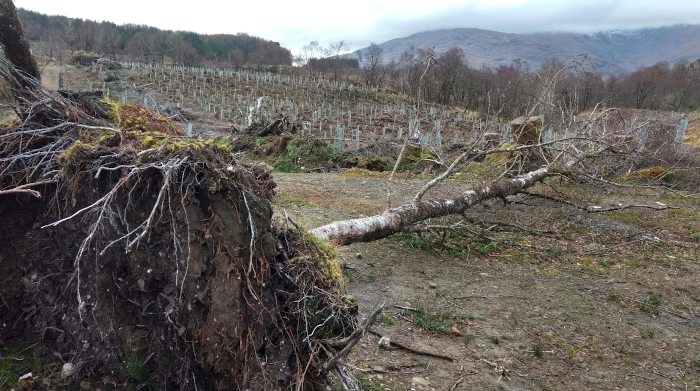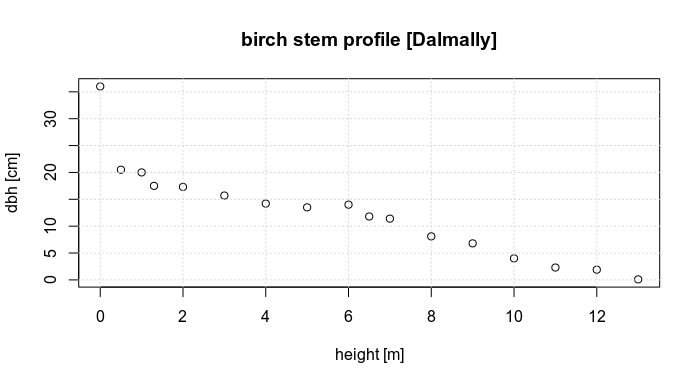Disclaimer: The documents, data and/or models produced here are for interest only and not subjected to formal validation or review. The aim is to explore open data and test its potential in forestry studies. Use at your own risk.
The volume of woody biomass in a tree stem can be estimated as a function of height, diameter and a form factor. The aim of this study is to test whether a form factor of 0.4 (a common default value) accurately represents the stem volume of a Betula spp (birch) tree.
A fallen birch tree (figure 1) was found on a forest path near the village of Dalmally on the West of Scotland. The whole tree length was measured, diameters recorded every 1m along the stem. Additionally measurements were recorded at 0.5m (stump height), stem midpoint, 1.3m (dbh) and the height at which diameter was 7cm (the smallest marketable diameter class).

Figure 1: A fallen birch tree provides the opportunity to measure stem taper.
The volume was estimated using four methods:
The stem taper profile is shown in figure 2 and the measurements are listed in table 1. The performance of various estimation methods of volume are listed in table 2.

Figure 2: Stem taper profile for a fallen birch tree.
Table 1: Height and diameter measurements along the stem. * volume doubled due to forked stem.
| Height (m) | Diameter (cm) | Volume in section (m3) |
| 0.00 | 36.0 | - |
| 0.50 | 20.5 | 0.0313 |
| 1.00 | 20.0 | 0.0161 |
| 1.30 | 17.5 | 0.0083 |
| 2.00 | 17.3 | 0.0166 |
| 3.00 | 15.7 | 0.0214 |
| 4.00 | 14.2 | 0.0176 |
| 5.00 | 13.5 | 0.0151 |
| 6.00 | 14.0 | 0.0148 |
| 6.50 | 11.8 | 0.0065 |
| 7.00 | 11.4 | 0.0053 |
| 8.00 | 8.1 | 0.0075 x 2* |
| 9.0 | 6.8 | 0.0044 x 2* |
| 10.0 | 4.0 | 0.0023 x 2* |
| 11.0 | 2.3 | 0.0008 x 2* |
| 12.0 | 1.9 | 0.0003 x 2* |
| 13.0 | 0.1 | 7.85E-05 x 2* |
Table 2: Volume estimates from four methods applied to the data in table 1.
| Model | Volume (m3) |
| Sum of all sections | 0.184 |
| Sum of all sections above 0.5m | 0.153 |
| Sum of all sections above 0.5m and diameter > 7cm | 0.136 |
| Cone | 0.105 |
| 0.4 Form factor | 0.126 |
| 0.5 Form factor | 0.158 |
| 17.9cm dbh birch mean tree volume (James, 1982) | 0.168 |
The cone representation of the stem underestimated volume above 0.5m by ~50%. If the definition of volume was timber (defined as diameter class > 7cm) a 0.4 form factor was closer to the actual volume, but for the whole stem above above 0.5m a 0.5 form factor produced the best result.
The birch tree in this study was wind blown in the spring of 2019 (it still had some leaves at time of measurement). It was on the edge of a conifer stand that had been felled around 2017 so is likely to have self seeded. The tree had a low height diameter ratio suggesting it had not been subjected to much competition in its life - suggesting it would have a higher volume than normal. However the mean volume of a tree of 17.9 dbh thinning from sycamore, ash and birch yield tables in James (1982) was quoted as 0.168m3 which is slightly higher than the values here. This may be because the stump height here was assumed to be 0.5m and the stem was forked.
Form factors should be used appropriate to the question being asked. For timber purposes the form factor might exclude the stem below diameter 7cm, but for biomass and carbon accounting the whole tree volume should be accounted for in the form factor. Table 3 provides suggested form factors for birch based on the tree studied (those include bark). More sample trees are required to develop those form factors however, and the sample tree here included a fork in the stem above 8m.
Table 3: Provisional form factors for birch.
| Volume estimate type | Form factor |
| Whole stem above ground | 0.58 |
| Whole stem above 0.5m | 0.48 |
| Timber (minimum diameter 7cm) | 0.44 |
A form factor of 0.5 provides the best general estimate of tree volume for birch. More work is needed to test how form factor varies within populations and across across age/size classes.
Stem taper form factor birch Betula spp Scotland UK